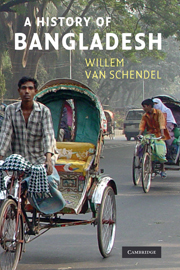Book contents
- Frontmatter
- Contents
- List of plates
- List of maps and figures
- Acknowledgements
- Timeline
- Introduction
- PART I THE LONG VIEW
- 1 A land of water and silt
- 2 Jungle, fields, cities and states
- 3 A region of multiple frontiers
- 4 The delta as a crossroads
- PART II COLONIAL ENCOUNTERS
- PART III BECOMING EAST PAKISTAN
- PART IV WAR AND THE BIRTH OF BANGLADESH
- PART V INDEPENDENT BANGLADESH
- Conclusion
- Bangladesh district maps
- Key political figures since 1947
- Glossary of Bengali terms
- Notes
- Bibliography
- Index
1 - A land of water and silt
Published online by Cambridge University Press: 05 February 2015
- Frontmatter
- Contents
- List of plates
- List of maps and figures
- Acknowledgements
- Timeline
- Introduction
- PART I THE LONG VIEW
- 1 A land of water and silt
- 2 Jungle, fields, cities and states
- 3 A region of multiple frontiers
- 4 The delta as a crossroads
- PART II COLONIAL ENCOUNTERS
- PART III BECOMING EAST PAKISTAN
- PART IV WAR AND THE BIRTH OF BANGLADESH
- PART V INDEPENDENT BANGLADESH
- Conclusion
- Bangladesh district maps
- Key political figures since 1947
- Glossary of Bengali terms
- Notes
- Bibliography
- Index
Summary
Imagine yourself high in the air over the Himalayas. Look down and you see a forbidding landscape of snow-capped mountains and harsh vegetation. But now look to the south-east and discover an immense floodplain stretching between the mountains and the sea. That shimmering green expanse is Bangladesh.
You may well wonder why a book about Bangladesh should begin with the Himalayas. There is a good reason: without the Himalayas, Bangladesh would not exist. In a sense, Bangladesh is the Himalayas, flattened out. Every spring the mountain snow melts and the icy water sweeps along particles of soil, forming into rivers that rush to the sea. As these rivers reach the lowlands, they slow down and deposit those particles, building up a delta. This age-old process has created the territory that we now know as Bangladesh – a territory that pushes back the sea a little further with every annual deposit of new silt.
The delta is huge because almost all water running off the Himalayas, the highest mountain range on earth, has to pass through it (Map 1.1). On the southern side numerous rivulets and rivers run together to form the mighty Ganges that flows eastwards through India for hundreds of kilometres before it enters western Bangladesh, where it is also known as the Padma. On the northern side of the Himalayas an equally majestic river, the Brahmaputra (or Tsangpo), forms in Tibet.
- Type
- Chapter
- Information
- A History of Bangladesh , pp. 3 - 10Publisher: Cambridge University PressPrint publication year: 2009



